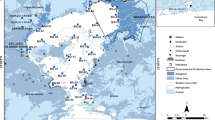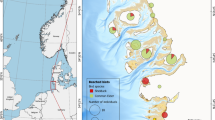Abstract
Beached organic debris was surveyed from May to November 2007 in monthly intervals on the Kachelotplate, a sandbank island west of Juist, Southern North Sea. Among the material recorded were peat, macroalgal wrack, and cadavers of birds and seals. In addition diatom foam as well as seal and bird faeces contribute to the organic matter import to the emerging island. Most of the beached material remains on the island for a short time only but finely ground peat originating from subaqueous shallow water erosion may be distributed widely by aeolian transport and become incorporated into surface sediments.
Similar content being viewed by others
References
Atkinson, M.J. &Smith, S.V. (1983): C:N:P ratios of benthic marine plants. — Limnology and Oceanography,28: 568–574.
Atlas, E. &Pytkowicz, R.M. (1977): Solubility behavior of apatites in seawater. — Limnology and Oceanography,22: 290–300.
Behre, K.-E. &Kučan, D. (1994): Die Geschichte der Kulturlandschaft und des Ackerbaus in der Siedlungskammer Flögeln, Niedersachsen, seit der Jungsteinzeit. — Probleme der Küstenforschung im südlichen Nordseegebiet,21: 5–227.
Beug, H.-J. (2004): Leitfaden der Pollenbestimmung für Mitteleuropa und angrenzende Gebiete. — 542 pp.; München (Pfeil).
Böckle, B. &Müller, R. (1997): Reduction of disulfide bonds byStreptomyces pactum during gowth on chicken feathers. — Applied Environmental Microbiology,63: 790–792.
Colombini, I. &Chelazzi, L. (2003): Influence of marine allochthonous input on sandy beach communities. — Oceanography and Marine Biology Annual Review,41: 115–159.
Czeck, R. &Paul, M. (2008): Grey seals — a home-coming species in the Wadden Sea. — Senckenbergiana maritime,38 (2): 143–146.
Doyle, T.K., Houghton, J.D.R., McDevitt, R., Davenport, J. &Hays, G.C. (2007): The energy density of jellyfish: Estimates from bomb-calorimetry and proximate-composition. — Journal of Experimental Marine Biology and Ecology,343: 239–252.
Dugan, J.E., Hubbard, D.M., McCrary, M.D. &Pierson, M.O. (2003): The response of macrofauna communities and shore-birds to macrophyte wrack subsidies on exposed sandy beaches of southern California. — Estuarine, Coastal and Shelf Science,58: 25–40.
Farlow, J.O. &Arngast, A. (2006): Preservation of fossil bone from the Pipe Creek sinkhole (Late Neogene, Grant County, Indiana, U.S.A.). — Journal of the Paleontogical Society of Korea,22: 51–75.
Firbas, F. (1949): Waldgeschichte Mitteleuropas, 1. Band. — 480 pp.; Jena (Fischer).
Freund, H. (1995): Pollenanalytische Untersuchungen zur Vegetations- und Siedlungsentwicklung im Moor am Upstalsboom, Ldkr. Aurich (Ostfriesland, Niedersachsen). — Probleme der Küstenforschung im südlichen Nordseegebiet,23: 117–152.
Goethe, F. (1936): Larven von Seetangfliegen als Nahrung für durchziehende Limicolen in Helgoland. — Beiträge zur Fortpflanzungsbiologie der Vögel,12.
Grosse-Brauckmann, G. (1963): Über die Artzusammensetzung von Torfen aus dem nordwestdeutschen Marschen-Randgebiet. — Vegetatio,11: 325–341.
Jędrzejczak, M.F. (2002): StrandedZostera marina L. vs wrack fauna community interactions on a Baltic sandy beach (Hel, Poland): a short-term pilot study. Part II. Driftline effects of succession changes and colonisation of beach fauna. — Oceanologia,44: 367–387.
Kuznetsova, M. &Lee, C. (2002): Dissolved free and combined amino acids in nearshore seawater, sea surface microlayers and foams: Influence of extracellular hydrolysis. — Aquatic Sciences,64: 252–268.
Köller, C. (2002): Paläochemotaxonomie von Torfen Nordwestdeutschlands. — 131pp., Ph.D. Thesis, Carl von Ossietzky University, Oldenburg.
Liebezeit, G. (1995): Particulate phosphorus fractions in a mangrove estuary. — Senckenbergiana maritima,25: 123–126.
Liebezeit, G. (2008): Marine litter on the Kachelotplate, Lower Saxonian Wadden Sea. — Senckenbergiana maritima,38 (2): 147–151
Liu, X., Zhao, S., Sun, L., Yin, X., Xie, Z., Honghao, L. &Wang, Y. (2006): P and trace metal contents in biomaterials, soils, sediments and plants in colony of red-footed booby (Sula sula) in the Dongdao Island of South China Sea. — Chemosphere,65: 707–715.
Lloyd, C., Tasker, M.L. &Partridge, K. (1991): The Status of Seabirds in Britain and Ireland. — 355 pp., T & AD Poyser (London).
Moore, P.D., Webb, J.A. &Collinson, M.E. (1991): Pollen analysis. — 2nd ed., 216 pp.; Oxford (Blackwell).
Murray, S. &Wa:nless, S. (1986): The status of the gannet in Scotland 1984–5. — Scottish Birds.14, 74–85.
Murray, S., &Wanless, S. (1997): The status of the gannet in Scotland in 1994–95. — Scottish Birds,19: 10–27.
Muhsin, T. &Hadi, R. (2002): Degradation of keratin substrates by fungi isolated from sewage sludge. — Mycopathologia,154: 185–189.
Niedringhaus, R. &Lieckweg, T. (2008): First steps of arthropod colonization on an embryonic dune island. — Senckenbergiana maritima,38 (2): 131–135.
Nriagu, J.O. (1983): Rapid decomposition of fish bones in Lake Erie sediments — Hydrobiologia,106: 217–222.
Olabarria, C., Lastra, M. &Garrido, J. (2007): Succession of macrofauna on macroalgal wrack of an exposed sandy beach: Effects of patch size and site. — Marine Environmental Research,63: 19–40.
Overbeck, F. (1975): Botanisch-geologische Moorkunde. — 719 pp.; Neumünster (Wachholtz).
Pandian, P. &Venugopalan, V.K. (1975): Studies on foam. — Journal of the Marine Biological Association of India,17: 175–180.
Papadopoulos, M.C. (1986): The effect of enzymatic treatment on amino content and nitrogen characteristics of feather meal. — Animal Feed Science Technology,16: 151–156.
Pavia, H., Cervin, G., Lindgren, A. &Aberg, P. (1997): Effects of UV-B radiation and simulated herbivory on phlorotannins in the brown algaAscophyllum nodosum. — Marine Ecology Progress Series,157: 139–146.
Petzelberger, B.E.M., Behre, K.-E. &Geyh, M.A. (1999): Beginn der Hochmoorentwicklung und Ausbreitung der Hochmoore in Nordwestdeutschland. — Telma,29: 21–38.
Remmert, H. (1958): Der Strandanwurf als Lebensraum. — Zoomorphology,48: 461–516.
Robinson, J.D., Mann, K.H. &Novitsky, J.A. (1982): Conversion of the particulate form of seaweed detritus to bacterial biomass. — Limnology and Oceanography,27: 1072–1079.
Roch, F. (1927): Die Holz- und Steinschädlinge der Meeresküsten und ihre Bekämpfung. Veröffentlichungen der Medizinalverwaltung,24: 1–78.
Rothmaler, W. (2002): Exkursionsflora von Deutschland. Band 4. Gefäßpflanzen: Kritischer Band. — 9th ed., 948 pp.; Berlin (Spektrum).
Schäfer, A. (1962): Aktuo-Paläontologie nach Studien in der Nordsee. — pp. 666, Verlag Waldemar Kramer (Frankfurt/Main).
Scheiffarth, G. &Becker, P.H. (2008): Roosting birds in the Oosterems area: spatial and seasonal aspects in 2007. — Senckenbergiana maritima,38 (2): 137–142.
Schneider, G. (1988): Chemische Zusammensetzung und Biomasseparameter der OhrenqualleAurelia aurita. — Helgoland Marine Research,42: 319–327.
Sival, F.P. &Strijkstra-Kalk, M. (1999): Atmospheric deposition of acidifying and eutrophicating substances in dune slacks. — Water, Air and Soil Pollution,116: 461–477.
Smith, D.G. &Young, E.G., 1953. On the nitrogenous constituents ofFucus vesiculosus. — Journal of Bioligcal Chemistry,205: 849–858.
Streif, H. (1990): Das ostfriesische Küstengebiet Nordsee, Inseln, Watten und Marschen. Sammlung geologischer Führer 57, pp. 376. Berlin, Gebr. Borntraeger.
Tomassen, H.B.M., Smolders, A.J.P., Lamers, L.P.M. &Roelofs, J.G.M. (2005): How bird droppings can affect the vegetation composition of ombrotrophic bogs. — Canadian Journal of Botany,83: 1046–1056.
Tucker, M.A. &Powell, A.N. (1999): Snowy plover diets in 1995 at a coastal southern California breeding site. — Western Birds,30: 44–48.
van der Poel, A.F.B. &Boushy, A.R.E. (1990): Processing methods for feather meal and aspects of quality. — Netherlands Journal of Agricultural Science,38: 681–695.
van Straaten, L.M.J.U. (1954): Composition and structure of recent marine sediments in The Netherlands. — Leidse Geologische Mededelingen,19: 1–110.
Velimirov, B. (1980): Formation and potential trophic significance of marine foam near kelp beds in the Benguela upwelling system. — Marine Biology,58: 311–318.
Verhoeven, R. (2001): Response of soil microfauna to organic fertilization in young coastal dune soils. — Biology and Fertility of Soils,34: 390–396.
Volkman, J.K., Rohjans, D., Rullkötter, J., Scholz-Böttcher, B.M. &Liebezeit, G. (2000): Sources and diagenesis of organic matter in tidal flat sediments from the German Wadden Sea. — Continental Shelf Research,20: 1139–1158.
Wolters, S., Zeiler, M. &Bungenstock, F. (2007): Pollen analytical and geochemical investigations of a submarine peat-silt sequence towards the reconstruction of early Holocene transgressional processes in the southern North Sea. — Terra Nostra, Vol.2007/1–2: 236.
Wöstmann, R. (2007): Biomarker in torfbildenden Pflanzen und ihren Ablagerungen im nordwestdeutschen Küsteraum als Indikatoren nacheiszeitlicher Vegetationsänderungen. — 212pp., Ph.D. Thesis, Carl von Ossietzky Universität, Oldenburg.
Zak, D. &Gelbrecht, J. (2007): The mobilisation of phosphorus, organic carbon and ammonium in the initial stage of fen rewetting (a case study from NE Germany). — Biogeochemistry,85: 141–151.
Author information
Authors and Affiliations
Rights and permissions
About this article
Cite this article
Liebezeit, G., Wöstmann, R. & Wolters, S. Allochthonous organic matter as carbon, nitrogen and phosphorus source on a sandbank island (Kachelotplate, Lower Saxonian Wadden Sea, Germany). Senckenbergiana maritima 38, 153–161 (2008). https://doi.org/10.1007/BF03055292
Received:
Accepted:
Issue Date:
DOI: https://doi.org/10.1007/BF03055292




